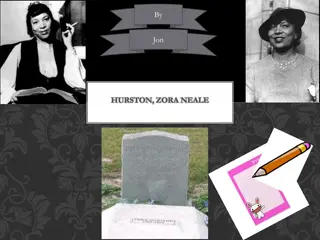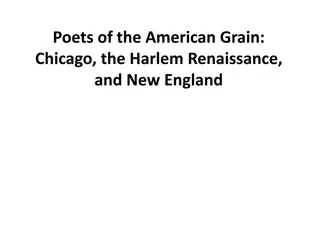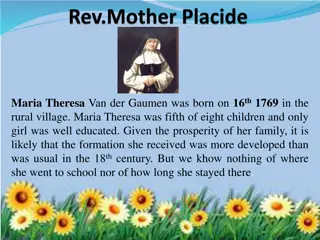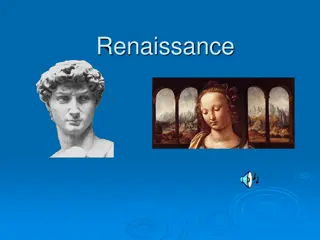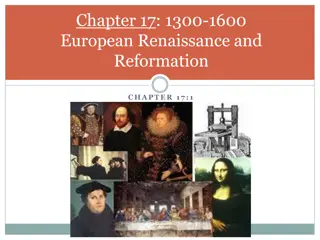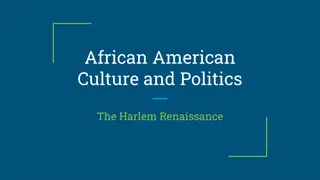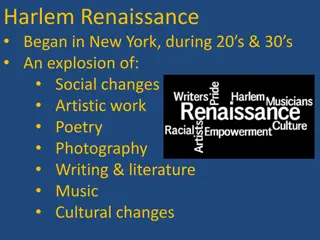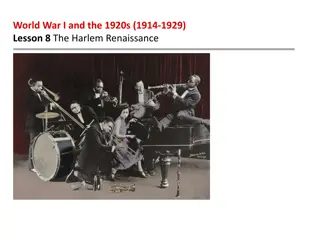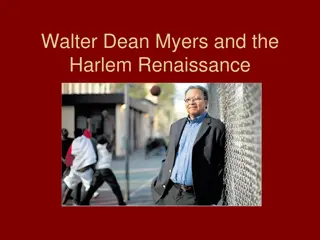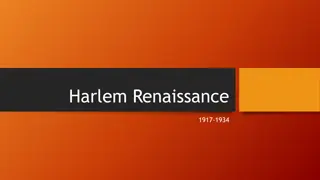The Harlem Renaissance and James Van Der Zee: A Cultural Exploration
The Harlem Renaissance was a significant period of cultural and intellectual expression, primarily in Harlem, New York, amidst Jim Crow discrimination and the Great Migration. This era saw a flourishing of African American literature, theatre, and art, challenging stereotypes and promoting racial pride. James Van Der Zee, a renowned photographer, captured the essence of Black New Yorkers during this period through his iconic portraits that reflected the aspirations and humanity of his subjects. His work remains a testament to the artistic and social vibrancy of the time.
Download Presentation

Please find below an Image/Link to download the presentation.
The content on the website is provided AS IS for your information and personal use only. It may not be sold, licensed, or shared on other websites without obtaining consent from the author.If you encounter any issues during the download, it is possible that the publisher has removed the file from their server.
You are allowed to download the files provided on this website for personal or commercial use, subject to the condition that they are used lawfully. All files are the property of their respective owners.
The content on the website is provided AS IS for your information and personal use only. It may not be sold, licensed, or shared on other websites without obtaining consent from the author.
E N D
Presentation Transcript
THE HARLEM RENAISSANCE AND JAMES VAN DER ZEE BAAS History Resources Series: The Jazz Age
WHAT IS THE HARLEM RENAISSANCE? The Harlem Renaissance was a period of cultural and intellectual expression that centered on the neighborhood of Harlem, New York. It included a flourishing in African American literature, theatre, and art. It took place against a backdrop of Jim Crow discrimination, which continued the practice of racist segregation through violence (including lynching's), literacy tests, and stereotypes. Another contextual factor was the Great Migration, which say nearly 1 million African Americans leave the South to Northern urban cities such as New York. Notable figures of the era included poets and novelists, including Langston Hughes, Claude McKay, and Zora Neale Hurston. A prevailing ideology was that of the New Negro the artistic rejection of stereotypes that white people had held of African Americans, increased racial pride, and a desire to express oneself creatively.
WHO IS JAMES VAN DER ZEE? James Van Der Zee was a photographer of Black New Yorkers during the Harlem Renaissance. In 1917, he opened Guarantee Photo Studio at 109 135th Street, Harlem. He would cater to a middle-class, African American clientele throughout the 1920s and 1930s. With the rise of the personal camera, his studio declined in popularity, becoming effectively obsolete by the 1950s. Toni Morrison said of Van Der Zee s photographs: What is so clear in his pictures and so marked in his words is the passion and the vision, not of the camera but of the photographer [ ] The narrative quality, the intimacy, the humanity of his photographs [is] stunning. (Right) Self portrait of James Van Der Zee, taken in 1918. Image accessed through Wikimedia Commons: https://commons.wikimedia.org/wiki/File:James_Van_Der_Zee.jpg. This work is in the public domain due to its publication in 1918.
PHOTOGRAPHY - PORTRAIT Van Der Zee is most famous for his portraits. Middle-class African Americans would visit his studio to have their photographs taken. Deborah Willis argues that many of Van Der Zee s photographs exemplify the Pictorial aesthetic which maintain a quiet and meditative quality. His use of props, backdrops, and evocation of a sentimental aesthetic fit within this tradition. Van Der Zee said of his portraits that I put my heart and soul into them and tried to see that every picture was better-looking than the person. If it wasn t better looking than the person I was taking, then I wasn t satisfied with it. What adjectives would you use to describe the appearance of the people in this photo? (Left): James Van Der Zee,Wedding Day, Harlem, 1926. Source: Wikimedia Commons https://commons.wikimedia.org/wiki/File:VDZ_Wedding_Day.jpg This work is in the public domain due to its publication in 1926.
PHOTOGRAPHY - STREET PHOTOGRAPHY James Van Der Zee also took photographs of Harlem itself, and of people moving through it. In 1919, he photographed the victory parade of the returning 369th Infantry Regiment, a predominantly African American unit sometimes called the "Harlem Hellfighters. A 1932 portrait is one of Van Der Zee s most famous: with their fur coats and car, the figures represent the middle-class aspirations of African Americans at the time. See the photo here: https://www.moma.org/collection/works/180240 Van Der Zee s street photography gives us a glimpse of his method outside of the carefully curated studio environment. What might street photography tell us about history that portrait photography cannot?
PHOTOGRAPHY FUNERAL PHOTOGRAPHY Van Der Zee also took funeral photography for the African American community images of the deceased and their families. In these images, Hughes would often manipulate the photographs to include biblical figures, angels, or poetry. The Harlem Book of the Dead (1978) put these photographs alongside poetry about death and an interview with Van Der Zee. Diana Emery Hulick The distinctive opulence of Van Der Zee's funeral photographs [ ] is a way of showing how much the living cared for those now dead, as well as using details of dress and superimposed imagery to construct visual archetypes of mothers, fathers, children, women, soldiers, and mourners Why do you think funeral photography was so important to the African American community?
THE HARLEM ON MY MIND EXHIBITION James Van Der Zee s work was represented in the controversial Harlem on My Mind: Cultural Capital of Black America exhibition in 1969 at the Metropolitan Museum of Art. The exhibition was controversial because it excluded Black artists, and there was racist, and anti-Irish and antisemitic language present in the catalogue. There were no paintings, drawings or sculptures instead, a narrative was presented to the viewer using newspaper clippings, soundscapes, and reproductions of Van Der Zee s (and Gordon Parks s) photographs. It drew attention to the lack of diversity in museum spaces. The exhibition also renewed interest in Van Der Zee s work, with Cooks calling the exhibition the pivotal event of his career.
WORKS CITED Emilie Boone, Reproducing the New Negro: James Van Der Zee's Photographic Vision in Newsprint, American Art, 34.2 (2020): 4-25. Bridget R. Cooks, Black Artists and Activism:Harlem on My Mind (1969), American Studies, 48.1 (Spring 2007): 5-39. Bridget R. Cooks,Exhibiting Blackness: African Americans and the American Art Museum (University of Massachusetts Press, 2011) Jim Haskins, James Van DerZee: The Picture-Takin' Man (Dodd, Mead & Company, 1979) Diana Emery Hulick, James Van Der Zee's Harlem book of the dead, History of Photography, 17.3 (1993): 277-283. Deborah Willis, Reflections in Black: A History of Black Photographers, 1840 to the Present (New York & London: W.W. Norton, 2000) Deborah Willis-Braithwaite, VanDerZee: Photographer, 1886-1983 (New York: H.N. Abrams, 1993) James Van Der Zee, The Harlem Book of the Dead (New York: Morgan & Morgan, 1978)
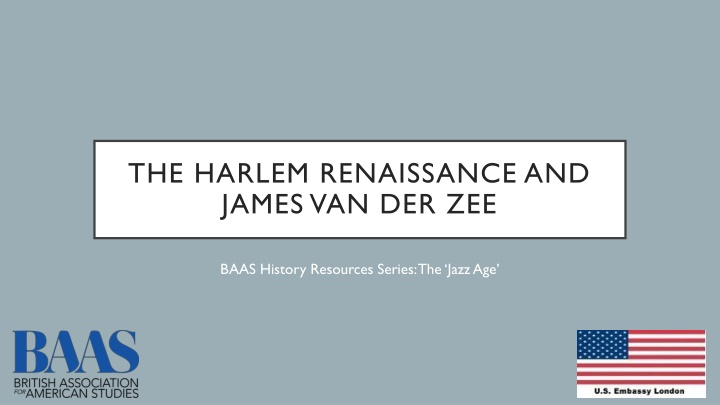

![❤[PDF]⚡ Zee Zee Does It Anyway!: A Story about down Syndrome and Determination](/thumb/20462/pdf-zee-zee-does-it-anyway-a-story-about-down-syndrome-and-determination.jpg)
